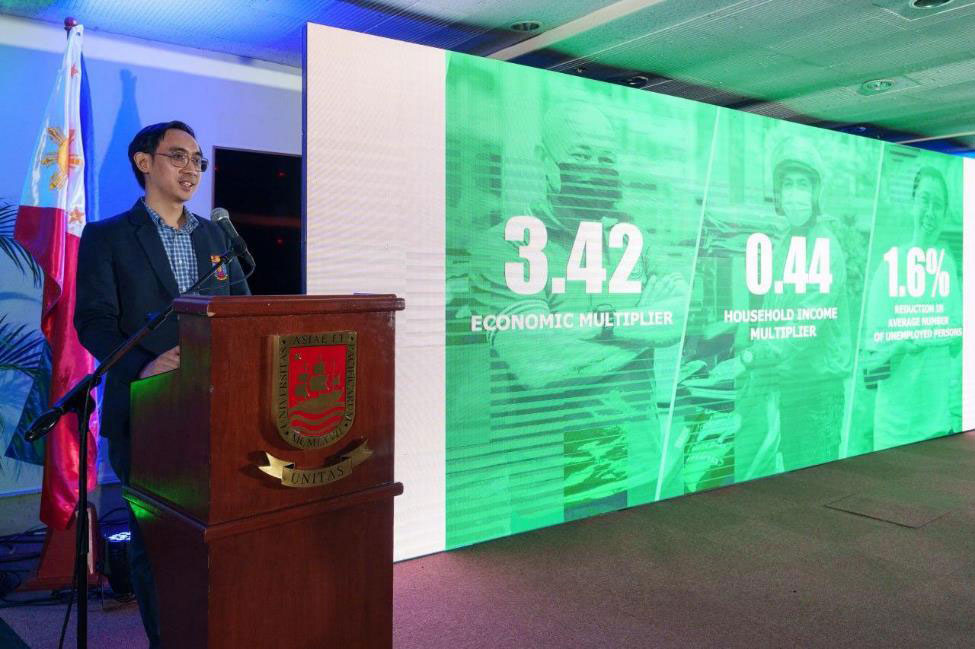
DRIVING THE PHILIPPINES FORWARD. UA&P Resident Industry & Regional Economist Prof. Greg Mabbagu (R) delves into the intricacies of Grab’s economic multiplier effect, emphasizing its pivotal role in propelling the Philippine economy forward. L-R: Paolo Abrera, event moderator; Dr. Cid Terosa, UA&P School of Economics Associate Professor; Dr. Thomas Aquino, Senior Fellow at CRC.
Manila, Philippines, 12 March 2024 – Grab Philippines plays a pivotal role in driving economic growth, creating livelihood opportunities, and significantly contributing to the national GDP, according to a study conducted by the Center for Research and Communication (CRC).
The study, commissioned by a third-party consultancy firm, titled ‘The Impact of Ride-Hailing and On-Demand Delivery Services on the Philippine Economy: A Focus on Grab Philippines’, ascertained that Grab’s economic influence is evident in its unique ability to amplify economic returns.
For every peso spent on the Grab platform, an additional P3.42 is injected into the national economy. This multiplier effect surpasses industry benchmarks — positioning Grab as a major economic contributor within the transportation sector. The fundamental idea is that with a hypothetical P100-GrabCar ride, an additional Php 342 is generated for the economy.
“Our study shows that Grab – with its strong foothold in the Philippines, its technology, portfolio of services, and robust ecosystem of partners and merchants, has a remarkable capacity to propel our economy forward. Having the unique position as a superapp has allowed Grab to fully realize a multiplier effect that reverberates throughout the economy and the Filipino household” said Dr. Cid L. Terosa, UA&P Associate Professor, Senior Economist and Input-Output Analysis Specialist.
Grab’s ripple effect: Economic and household multipliers

ECONOMIC MULTIPLIER. UA&P Resident Industry & Regional Economist Prof. Greg Mabbagu shares Grab’s success ripples through the economy, livelihood creation, and households — that for every peso spent on Grab’s services, P3.42 is injected back into the economy.
With a total output multiplier of 3.42, Grab ranks third among seven transport sectors next to railway and air transport. Moreover, compared with available multiplier studies published in local economics journals, this multiplier significantly outpaces heavy industries like mining, highlighting Grab’s unique and substantial economic contributions.
The study found that consumer patronage of Grab services accounts for 0.07 to 0.3 percent of the national GDP. From 2019 to 2021, Grab’s estimated total economic contribution ranges from P37 billion to P165.6 billion, reinforcing its position as a key contributor to the national economy.
The household income multiplier of 0.44 also suggests that every additional peso spent on Grab’s services stimulates an increase of P0.44 in the national household income. This implies that an extra peso spent on Grab services extends beyond just covering the actual ride or meal – it contributes an additional 44 centavos to household incomes for laborers in the ride-hailing and on-demand delivery industry nationwide.
With this multiplier value for household income, Grab Philippines contributed 0.10 percent to 0.17 percent to the total family income from 2019 to 2021 which is equivalent to between P23.8 billion and P40.3 billion.
Generating livelihood opportunities
According to the study, Grab’s operations have also played a vital role in reducing the average number of unemployed persons by 1.1 percent to 1.6 percent from 2019 to 2021.
Grab’s mission-driven growth not only addresses major societal challenges but also fosters economic development across different regions in the Philippines. “This study showcases how expansive the positive impact of online marketplaces like Grab have on national and local economies, promoting a more balanced regional development. We are very optimistic that with the fast-growing adoption of digital-first ways of life, platforms like Grab will continue to be key economic drivers as they transform the lives of many Filipinos for the better,” Dr. Thomas Aquino, Senior Fellow at the CRC, commented on the study.
With Grab’s continued growth, it will continue to provide a greater positive impact on the economy and the Filipino society.
“Grab remains firm and focused in its commitment to being an active partner of the government in their growth and development agenda – and we are humbled to see this solidified in concrete economic outcomes. We understand that much work needs to be done in further driving the nation forward, and we are eager and prepared to help usher in a new phase of inclusive growth and prosperity – with the support of our partners in the government and public sector, and our regulators,” Grab Philippines Country Head Grace Vera Cruz said in a statement.
———————————————————–———————————————————–———————————————————
The Center for Research Communication (CRC) is the research and communication arm of the University of Asia and the Pacific, uniquely poised to help you with business feasibility evaluation, demand and supply analysis, partnership development, project impact evaluation, value chain analysis, customized solutions for design thinking, data analytics and insights generation, and development of business strategies, and consultancy services for investors in Philippine market.
To find out more about CRC, send an email to [email protected], or message +639054280727, or follow us on LinkedIn. You can also find us on Facebook.






